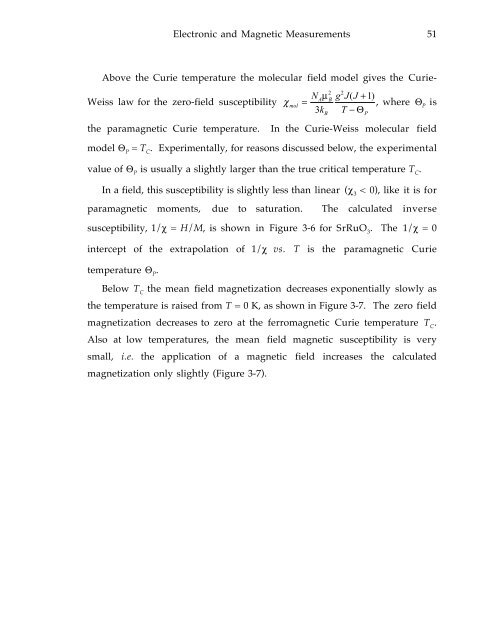MAGNETISM ELECTRON TRANSPORT MAGNETORESISTIVE LANTHANUM CALCIUM MANGANITE
MAGNETISM ELECTRON TRANSPORT MAGNETORESISTIVE LANTHANUM CALCIUM MANGANITE
MAGNETISM ELECTRON TRANSPORT MAGNETORESISTIVE LANTHANUM CALCIUM MANGANITE
You also want an ePaper? Increase the reach of your titles
YUMPU automatically turns print PDFs into web optimized ePapers that Google loves.
Electronic and Magnetic Measurements 51<br />
Above the Curie temperature the molecular field model gives the Curie-<br />
Weiss law for the zero-field susceptibility χ mol<br />
2 2<br />
NAμ<br />
B gJJ ( + 1)<br />
=<br />
3k<br />
T − Θ , where ΘP is<br />
B P<br />
the paramagnetic Curie temperature. In the Curie-Weiss molecular field<br />
model Θ P = T C . Experimentally, for reasons discussed below, the experimental<br />
value of Θ P is usually a slightly larger than the true critical temperature T C .<br />
In a field, this susceptibility is slightly less than linear (χ 3 < 0), like it is for<br />
paramagnetic moments, due to saturation. The calculated inverse<br />
susceptibility, 1/χ = H/M, is shown in Figure 3-6 for SrRuO 3 . The 1/χ = 0<br />
intercept of the extrapolation of 1/χ vs. T is the paramagnetic Curie<br />
temperature Θ P .<br />
Below T C the mean field magnetization decreases exponentially slowly as<br />
the temperature is raised from T = 0 K, as shown in Figure 3-7. The zero field<br />
magnetization decreases to zero at the ferromagnetic Curie temperature T C .<br />
Also at low temperatures, the mean field magnetic susceptibility is very<br />
small, i.e. the application of a magnetic field increases the calculated<br />
magnetization only slightly (Figure 3-7).
















